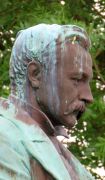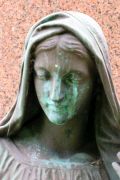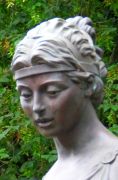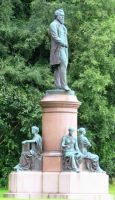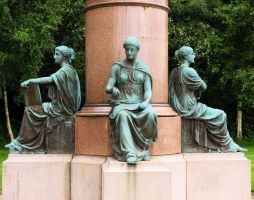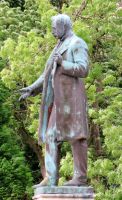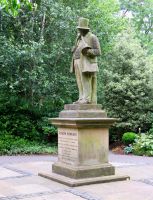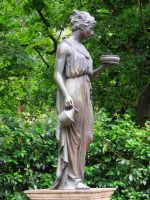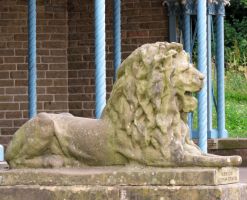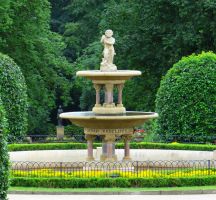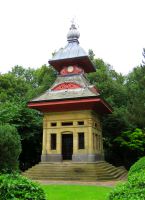Oldham Alexandra Park Sculpture
Oldham's Alexandra Park includes a crop of five statues, plus distinctive surviving Victorian structures, in pleasant surroundings. Click any picture to enlarge, or hover for caption.
Alexandra Park was Oldham's first park, created 'as a labour project for the unemployed during the Cotton Famine of the American Civil War', opened in 1865, designed by the local architects Woodhouse and Potts, and with the landscape gardening by a Mr Henderson, according to information displays in the park itself. It went through further periods of building later in the 19th Century, first in the 1880s, and again at the Jubilee of the incorporation of the borough council in 1899. Later, there was a period of decline and neglect, and the usual wilful destruction of things Victorian in the 1960s-70s, with more recent sympathetic restoration, to the credit of the local council, and the National Lottery Fund which provided significant funding.
In terms of statuary, we have three historic pieces: Robert Ascroft, John Platt, and Joseph Howarth, together with stone lions on the Pavilion and the Radcliffe fountain with a cherub, and two modern pieces, Emma (the Flower Girl) and Rebecca, modern pieces replacing lost statues.
John Platt, and figures at base.
Among the commemorative statues, we start with the grandest, which is the bronze statue to John Platt, with four allegorical female statues, also in bronze, at the base, by sculptor D.W. Stevenson. The figure is a typical standing Victorian statue, worthy and with a full beard. The four Classical girls around the base are more interesting, good of their type. Platt's company, called Platt Brothers [his co-owner and brother James died in 1857], was apparently at one time one of the largest textile engineering companies in the world. He was a major figure in Oldham in other ways too:, a pillar of the Oldham Corporation, Mayor on three occasions, and MP from 1865. He died in 1872, and the statue was erected by public subscription in 1878, which date is on the base. It stood by the Town Hall until 1924, when it was relegated to the Park. Groups like this with a full set of figures around the base are fairly rare, and there is a separate page on this ensemble.
Robert Ascroft MP.
Next is the statue of Robert Ascroft, Oldham's MP from 1895-1899, and entitled on its base 'The workers' friend'. The bronze statue is by the notable sculptor F.W. Pomeroy, and is a fair example of his portrait statuary. The face is whiskered but without beard, and somewhat sombre, and the comparison with the statue of Platt shows the superior craft of Pomeroy. As an MP, Ascroft is shown in a pose suggestive of oratory, one hand extended to make make some point, the other holding a lapel of his knee-length coat. He looks slightly downward to the viewer, as the granite plinth is of a good height.
Joseph Howarth. The earliest work is the statue of Joseph Howarth, a blind bellman, popular in the town, put up soon after the Park opened, in 1868. The statue is unfortunate: it appears to have been copied from a photograph of Howarth, is unsympathetic and naive in technique, wooden in pose, and being made in sandstone, decay seems to have prompted a modern replacement of different colour and equally poor treatment. It is the work of the sculptor H.Burnett of Oldham, who is obscure, and this may have been the piece that sealed his fate.
Rebecca, by Andrew Sinclair.
Two statues from the earliest days of the Park, one called The Flower Girl and the other being a version of Rebecca at the Well, have been lost, and modern replacements commissioned from the sculptor Andrew Sinclair, b.1961. Modern statues are not really a focus for this website, however the Rebecca, made as close as possible to the original as depicted in various postcards of the Park, is a good thing, in Classical garb and holding a Classical pitcher in one hand and flat pot in the other, and with a girlish figure and a face reminiscent of 1930s sculpture rather than 19th Century. The piece is stamped 'Ridgeway Sculpture Design', which is Sinclair's company.
Back to the earliest days of the Park; one of the buildings was a spiky ironwork Victorian Pavilion, and while that was demolished in the 1970s, the Heritage Lottery Fund supported a replacement, as faithful as possible to the original, now brightly painted. In front of it are the two rather worn but original lions that stood in front of of the old building. Worn stone, conventional in design and suitably leonine.
The Radcliffe Fountain, named for Josiah Radcliffe, is a three-level construction with a round-faced cherubic figure on top, holding a large scaly fish and surrounded by reeds. Stone, and with the supporting pillar shafts in coloured granite, with carved foliage and flowers to the capitals. Despite the Classical scheme, the proportions of the pillars give a bit of a Victorian Gothic look.
Lodge and observatory.
In terms of architecture, the centrepiece of the Park was the Refreshment Rooms, a high Victorian, orangery-like structure, which was demolished by the barbarians as late as 1970, however two Italianate lodges and gateposts do survive from 1865 – the one at the main entrance has a short tower and pitched roof, very 1860s. From later on, we have a quirky Observatory in the style of a Japanese Pagoda, built in 1899 for the borough's Golden Jubilee, and a 1907 conservatory. A modern bandstand captures at least the shape of the lost Victorian one.
See also this page for other sculpture in Oldham.
